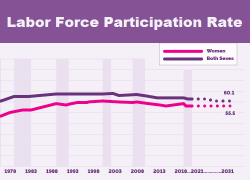 First celebrated as Women's History Week in 1980, following a Proclamation by then-President Carter, March marks Women’s History Month, a time to celebrate women’s historic contributions to all aspects of our society. In the last 12 months, we confirmed the first Black woman to the Supreme Court, the first Native American and Mexican women journeyed to space and, for the first time, a woman’s signature is now featured on our currency.
First celebrated as Women's History Week in 1980, following a Proclamation by then-President Carter, March marks Women’s History Month, a time to celebrate women’s historic contributions to all aspects of our society. In the last 12 months, we confirmed the first Black woman to the Supreme Court, the first Native American and Mexican women journeyed to space and, for the first time, a woman’s signature is now featured on our currency.
As we celebrate women’s historic ingenuity, resilience and grit, we at the Women’s Bureau also recognize the distance yet to travel to achieve full gender equality. Here in the United States and around the world, women continue to press for gender justice and basic human rights, raising our collective voices to clamor for the full measure of equity and equality that should be our birthright.
We acknowledge the headwinds we face. While women across this nation continue to face obstacles to receiving adequate reproductive care, including access to abortion, our country lacks paid family and medical leave, and paid sick time. Women are the backbone of our nation’s care infrastructure, both in paid and unpaid caregiving roles. And yet, our nation’s policies do not reflect the value of women’s work. We are still expected to manage competing care demands that force difficult, and sometimes impossible, choices between the families we love and the paychecks we need. This month, our research releases and public programming reflect a coordinated effort to report on objective measures reflecting the state of gender equity, or a lack thereof, while also centering the very real impact of women’s paid and unpaid caregiving roles on their ability to deliver as breadwinners for their families.
While women carry most caregiving responsibilities, our financial security is also undermined by the constant devaluing of women’s work. Women earn less than men within 94% of occupations, and there are no jobs where women have a statistically significant earnings advantage over men. Women-dominated career sectors are lower-paying, and barriers to accessing higher paying, male-dominated sectors persist. While some progress was made in the 1970s, 1980s and 1990s to reduce gender differences across occupations as more women entered the labor force and achieved higher levels of education, it stalled in the 2000s.
An intersectional analysis of changes in occupational segregation between 1983 and 2002 found that white women made more progress than Black and Hispanic women. The impacts of occupational segregation and disproportionate caregiving demands were exacerbated by the COVID-19 pandemic, eroding over 35 years of progress and leaving women’s labor force participation rate at its lowest level since 1985. While women are slowly recovering from the drastic setbacks from the pandemic, the long-term impacts are still unfolding.
Occupational segregation and unpaid caregiving in turn help to fuel a persistent gender pay gap that has budged little in recent years. To help make this concept more concrete, this month we updated our interactive data visualization on employment and earnings by occupation. Using this tool, people can clearly see how women are paid less than men in a majority of occupations and are heavily concentrated in leisure and hospitality, childcare and service occupations. We also updated our equal pay and pay transparency website, which serves as a central hub for academic papers, data and blogs on the topic, and features an interactive map of the U.S. detailing equal pay and pay transparency protections in each state, including statutory prohibitions against using salary history to set pay for prospective hires. We have introduced a new briefing paper outlining state and federal policy making, as well as principles and practices for equitable pay-setting not reliant on salary history.
Women’s labor and leadership form the foundation of our society. We are often the glue that holds families and communities together, as breadwinner and caregivers, and as community organizers who make our world a better place to live. Former Congresswoman Shirley Chisholm once said, “tremendous amounts of talent are lost to our society because that talent wears a skirt.” We can no longer sideline anyone in society, and we must keep women at the center of our nation’s future. We hope you’ll join us in this endeavor, leveraging our research, data, policy analysis, education and outreach to ensure that women’s career paths match their promise.
Wendy Chun-Hoon is the director of the U.S. Department of Labor’s Women’s Bureau. Follow the Women’s Bureau on Twitter at @WB_DOL.

 U.S. Department of Labor Blog
U.S. Department of Labor Blog





